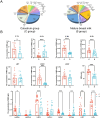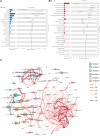Human milk microbiota and oligosaccharides in colostrum and mature milk: comparison and correlation
- PMID: 39726867
- PMCID: PMC11670000
- DOI: 10.3389/fnut.2024.1512700
Human milk microbiota and oligosaccharides in colostrum and mature milk: comparison and correlation
Abstract
Background: The interaction between the human breast milk microbiota and human milk oligosaccharides (HMOs) plays a crucial role in the healthy growth and development of infants. We aimed to clarify the link between the breast milk microbiota and HMOs at two stages of lactation.
Methods: The microbiota and HMOs of 20 colostrum samples (C group, 1-5 days postpartum) and 20 mature milk samples (S group, 42 days postpartum) collected from postpartum mothers were analyzed using 16S rRNA gene high-throughput sequencing and high-performance liquid chromatography-tandem mass spectrometry.
Result: The total average HMO content was significantly higher in the C group than in the S group (6.76 ± 1.40 g/L vs. 10.27 ± 2.00 g/L, p < 0.05). Among the HMOs, the average values of 2'-fucosyllactose (2'-FL, 1.64 ± 1.54 g/L vs. 3.03 ± 1.79 g/L), 3'-sialyllactose (3'-SL, 0.10 ± 0.02 g/L vs. 0.21 ± 0.06), 6'-SL (0.22 ± 0.09 g/L vs. 0.33 ± 0.11 g/L), and lacto-N-triaose 2 (LNT2, 0.03 ± 0.01 g/L vs. 0.16 ± 0.08 g/L) were significantly lower in the S group than in the C group (p < 0.05), while that of 3'-FL was significantly higher in the S group than in the C group (1.35 ± 1.00 g/L vs. 0.41 ± 0.43 g/L, p < 0.05). The diversity and structure of the microbiota in the S and C groups were also significantly different (p < 0.05). Comparative analysis of the microbial communities revealed that Proteobacteria and Firmicutes were the most abundant phyla, in both groups, with the keystone species (Serratia, Streptococcus and Staphylococcus) of breast milk closely interacting with HMOs, including 3'-SL, 6'-SL, and LNT2. In PICRUSt2 functional prediction analysis, the S group exhibited significant reduction in the expression of genes involved in several infectious disease pathways.
Discussion: Our findings support the recognition of human milk as a synbiotic comprising beneficial bacteria and prebiotic HMOs.
Keywords: breast milk; colostrum; human milk microbiota; human milk oligosaccharides; mature milk.
Copyright © 2024 Ge, Zhu, Zhang, Wang, Shi, Sun and Shi.
Conflict of interest statement
The authors declare that the research was conducted in the absence of any commercial or financial relationships that could be construed as a potential conflict of interest.
Figures





Similar articles
-
Human Milk Oligosaccharides Are Associated with Lactation Stage and Lewis Phenotype in a Chinese Population.Nutrients. 2023 Mar 15;15(6):1408. doi: 10.3390/nu15061408. Nutrients. 2023. PMID: 36986137 Free PMC article.
-
Lactational and geographical variation in the concentration of six oligosaccharides in Chinese breast milk: a multicenter study over 13 months postpartum.Front Nutr. 2023 Sep 5;10:1267287. doi: 10.3389/fnut.2023.1267287. eCollection 2023. Front Nutr. 2023. PMID: 37731395 Free PMC article.
-
[Levels of human milk oligosaccharides in breast milk of mothers delivering preterm infants of different gestational ages and their effects on early growth and development].Zhonghua Yu Fang Yi Xue Za Zhi. 2021 Sep 6;55(9):1067-1076. doi: 10.3760/cma.j.cn112150-20210513-00468. Zhonghua Yu Fang Yi Xue Za Zhi. 2021. PMID: 34619923 Chinese.
-
The Mean of Milk: A Review of Human Milk Oligosaccharide Concentrations throughout Lactation.Nutrients. 2021 Aug 9;13(8):2737. doi: 10.3390/nu13082737. Nutrients. 2021. PMID: 34444897 Free PMC article. Review.
-
Weighted analysis of 2'-fucosyllactose, 3-fucosyllactose, lacto-N-tetraose, 3'-sialyllactose, and 6'-sialyllactose concentrations in human milk.Food Chem Toxicol. 2022 May;163:112877. doi: 10.1016/j.fct.2022.112877. Epub 2022 Mar 16. Food Chem Toxicol. 2022. PMID: 35304182 Review.
References
-
- Cheng L, Akkerman R, Kong C, Walvoort MTC, de Vos P. More than sugar in the milk: human milk oligosaccharides as essential bioactive molecules in breast milk and current insight in beneficial effects. Crit Rev Food Sci Nutr. (2021) 61:1184–200. doi: 10.1080/10408398.2020.1754756, PMID: - DOI - PubMed
LinkOut - more resources
Full Text Sources

